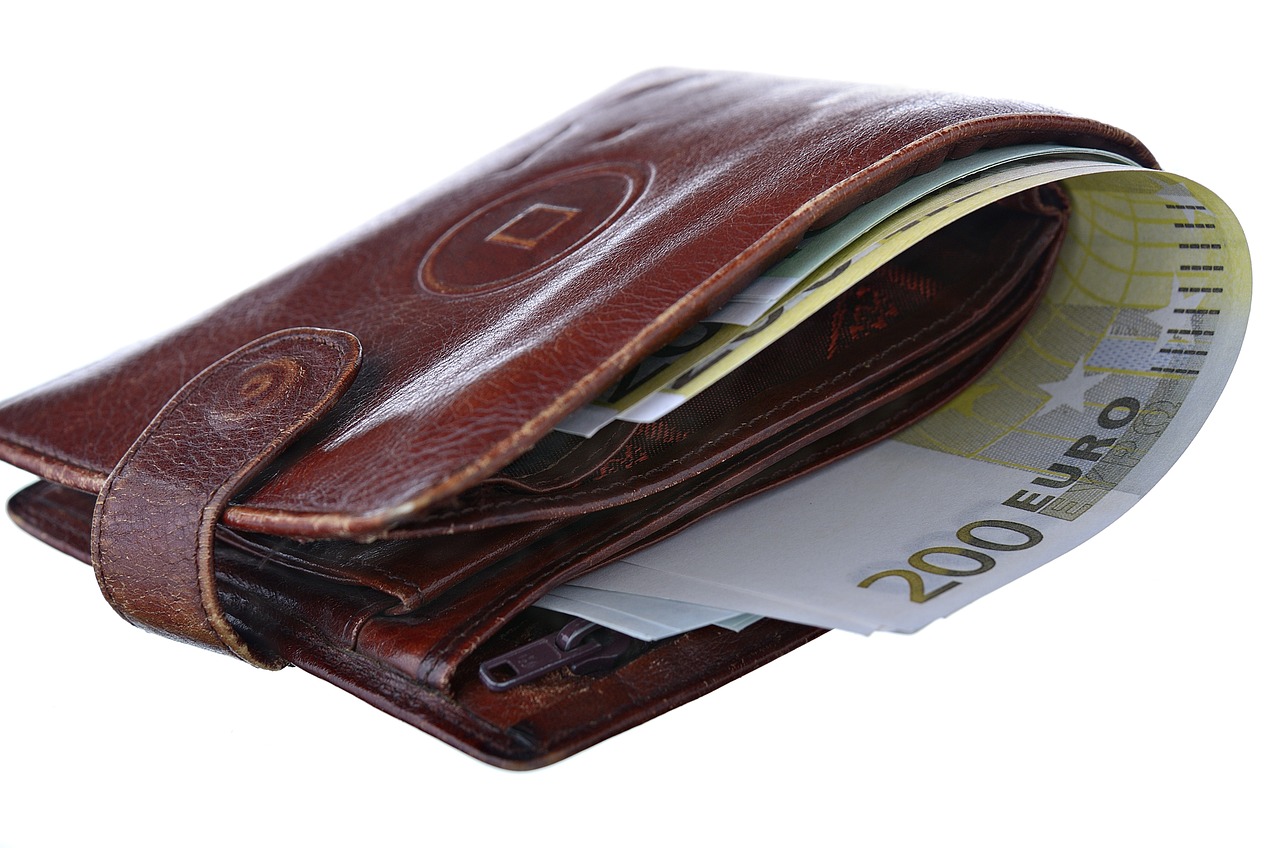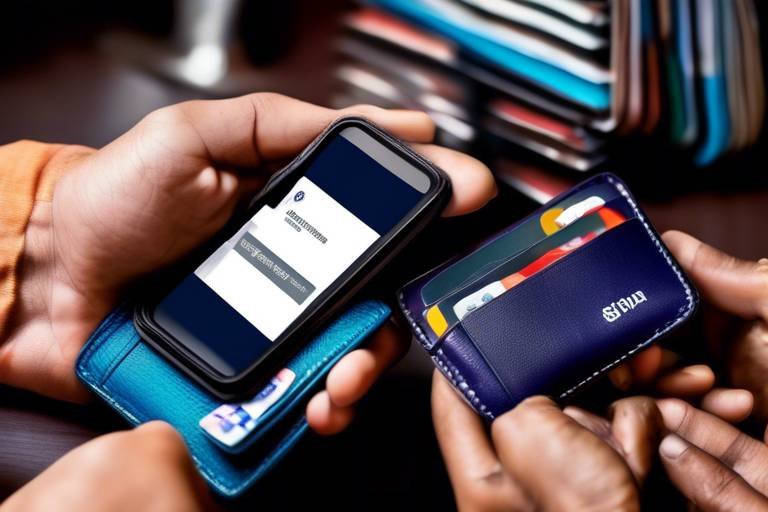The Importance of Wallet Innovation for Market Growth
In today's fast-paced digital world, the way we handle our finances is undergoing a seismic shift. Wallet innovation is at the forefront of this transformation, acting as a catalyst for market growth and enhancing how consumers interact with their money. Imagine a world where your wallet isn't just a physical object, but a dynamic digital tool that adapts to your needs and preferences. This is not just a dream; it's becoming a reality as technology evolves.
As we dive deeper into the significance of wallet innovation, we see that it encompasses a range of advancements, from improved security features to user-friendly interfaces. These innovations are not merely enhancements; they are essential components that shape consumer behavior and market trends. For instance, think about how frustrating it can be to navigate a clunky app or worry about the safety of your financial information. Wallet innovation addresses these pain points, making transactions smoother and more secure.
Moreover, the rise of digital wallets has opened up new avenues for businesses to engage with their customers. By leveraging innovative wallet features, companies can offer personalized experiences that resonate with individual users. This not only fosters loyalty but also drives increased adoption rates across various demographics. As more people embrace digital wallets, the market is poised for significant growth, fueled by the demand for convenience and security.
In summary, wallet innovation is not just a trend; it's a fundamental shift in how we perceive and use money. As we continue to explore this topic, we will uncover the various ways in which wallet innovations are impacting consumer behavior, enhancing user experiences, and adapting to the ever-changing market landscape.
- What is wallet innovation? Wallet innovation refers to advancements in digital wallets that improve features, security, and user experience.
- How does wallet innovation impact consumer behavior? It influences consumer behavior by providing convenience, security, and personalized experiences, leading to increased adoption.
- Why is user experience important in wallet innovation? A seamless user experience attracts and retains users, driving market growth.
- What role do emerging technologies play in wallet innovation? Technologies like blockchain and AI are reshaping wallet innovation by enhancing security and efficiency.

Understanding Wallet Innovation
Wallet innovation is a term that encompasses the rapid advancements in digital wallets, which have become an integral part of our daily financial interactions. These innovations are not just about storing money; they represent a significant shift in how we manage our finances, make purchases, and interact with businesses. As technology continues to evolve, so do the features and functionalities of digital wallets, making them more user-friendly and secure. In this digital age, understanding wallet innovation is crucial for both consumers and businesses alike.
At its core, wallet innovation refers to the enhancements made in various aspects of digital wallets, including features, security, and user experience. These advancements play a vital role in shaping consumer behavior and market trends. For instance, the introduction of biometric security measures—like fingerprint scanning and facial recognition—has significantly boosted user confidence in digital wallets. Consumers are more likely to adopt these technologies when they feel their financial information is secure.
Moreover, wallet innovation is not limited to just security features. It also includes the development of user-friendly interfaces that streamline the transaction process. Imagine trying to navigate a complex app while making a quick purchase; it can be frustrating! That's why companies are focusing on creating seamless experiences that allow users to complete transactions in just a few taps. This focus on usability is essential, as it directly impacts customer satisfaction and loyalty.
Additionally, the incorporation of personalization features into digital wallets has changed the game. By analyzing spending habits and preferences, wallets can offer tailored recommendations and rewards, enhancing user engagement. For example, if a user frequently shops at a particular store, the wallet might provide exclusive discounts or offers, making the user feel valued and understood. This level of personalization not only improves the user experience but also encourages repeat usage, driving market growth.
In summary, wallet innovation is a multifaceted concept that encompasses various aspects of digital wallet development. From enhancing security measures to improving usability and personalization, these innovations are crucial in meeting the evolving needs of consumers. As we continue to navigate the digital financial landscape, understanding wallet innovation will be key to unlocking new opportunities for growth and engagement.

Impact on Consumer Behavior
Innovative wallets are not just a passing trend; they're revolutionizing how consumers interact with their finances. Imagine walking into a store and making a purchase without ever reaching for your wallet. Instead, you simply tap your phone, and voilà! Transaction complete. This level of convenience significantly influences consumer behavior, making digital wallets an essential part of daily life. With features that streamline the payment process, users are more likely to adopt these technologies, leading to increased usage across various demographics.
One of the most compelling aspects of wallet innovation is its ability to enhance security. Consumers today are more aware of the risks associated with digital transactions. Therefore, wallets that prioritize robust security measures—like biometric authentication and encryption—instill a sense of trust. When users feel safe, they are more inclined to use these wallets for larger transactions, further driving market growth.
Moreover, personalized experiences are at the heart of modern wallet innovation. By analyzing spending habits, digital wallets can offer tailored recommendations and rewards. For instance, if a user frequently shops at a specific store, the wallet might provide exclusive discounts or loyalty points. This level of personalization not only improves user engagement but also fosters a deeper connection between consumers and the wallet service. It's like having a personal shopping assistant right in your pocket!
Additionally, the integration of innovative features such as budgeting tools and spending analytics can significantly impact consumer behavior. Users can track their expenses in real-time, leading to better financial decisions and increased satisfaction. When consumers feel empowered to manage their finances effectively, they are more likely to stick with a particular wallet service, contributing to its growth.
As we look at the broader implications of these innovations, it's clear that they are reshaping the landscape of consumer behavior. Wallets are no longer just tools for transactions; they are becoming integral to how people manage their financial lives. The more intuitive and user-friendly these wallets become, the more they will influence spending habits and overall market trends. In this rapidly changing digital financial landscape, staying ahead of the curve is essential for both consumers and providers alike.
- What features should I look for in a digital wallet? Look for security features, usability, personalization options, and integration with other financial tools.
- Are digital wallets safe to use? Yes, most digital wallets employ advanced security measures like encryption and biometric authentication to protect your information.
- How do digital wallets impact spending habits? Digital wallets can help users track their spending and offer personalized recommendations, influencing their purchasing decisions.
- Can I use a digital wallet for all my transactions? While many merchants accept digital wallets, it's always good to have a backup payment method just in case.

Enhancing User Experience
When it comes to digital wallets, enhancing user experience is not just a nice-to-have; it’s a game changer. Imagine walking into a store, and instead of fumbling through your wallet or searching for your phone, you simply tap your wrist, and voilà—your payment is complete! This kind of seamless interaction is what modern consumers crave. Wallet innovation focuses on creating interfaces that are not only visually appealing but also intuitive and efficient. Users should feel like they are gliding through their transactions, not trudging through a maze of options and buttons.
One of the key components of enhancing user experience is design. A well-designed digital wallet should have a clean layout that makes navigation a breeze. Consider how often you’ve abandoned an app because it was too complicated or cluttered. A digital wallet that prioritizes usability can significantly increase user satisfaction and retention. For instance, incorporating simple icons and clear categories can make it easier for users to locate their favorite features, whether that’s sending money to a friend or checking their transaction history.
Moreover, personalization is another critical aspect of user experience. What if your wallet could learn your spending habits and suggest tailored offers or rewards? Imagine receiving a notification for a discount at your favorite coffee shop, just when you’re about to make a purchase. This level of personalization not only enhances engagement but also creates a sense of loyalty. Users are more likely to stick with a wallet that understands their preferences and provides relevant suggestions.
To illustrate the importance of user experience in wallet innovation, let’s take a look at how different features can impact user satisfaction:
| Feature | Impact on User Experience |
|---|---|
| Seamless Interface | Reduces frustration, increases efficiency |
| Personalization | Enhances engagement, fosters loyalty |
| Security Features | Builds trust, encourages usage |
| Customer Support | Improves user satisfaction, resolves issues quickly |
Ultimately, enhancing user experience in digital wallets is about understanding the consumer journey. It’s about asking the right questions: How can we make payments easier? What features will resonate most with our users? By focusing on these aspects, wallet providers can create a product that doesn’t just meet expectations but exceeds them, leading to increased adoption and market growth.
- What is a digital wallet? A digital wallet is an electronic device or online service that allows individuals to make electronic transactions, store payment information, and manage their finances.
- How does user experience affect wallet adoption? A positive user experience can lead to higher satisfaction, increased usage, and greater loyalty, making users more likely to adopt and recommend the wallet.
- What role does security play in user experience? Security is crucial; users need to feel safe when using a digital wallet. Robust security features enhance trust and encourage usage.
- Can personalization improve user experience? Yes! Personalization can make users feel valued and understood, leading to higher engagement and satisfaction.

Design and Usability
This article explores how wallet innovation can drive market growth, enhance user experience, and adapt to evolving consumer needs in the digital financial landscape.
Wallet innovation refers to advancements in digital wallets, including features, security, and user experience, which play a crucial role in shaping consumer behavior and market trends.
Innovative wallets can significantly influence consumer behavior by providing convenience, security, and personalized experiences, leading to increased adoption and usage among various demographics.
User experience is paramount in wallet innovation, as seamless interfaces and efficient functionalities can attract and retain users, ultimately driving market growth.
The design and usability of digital wallets are critical factors that impact user satisfaction. Imagine walking into a store where everything is organized, easy to find, and inviting. That's the kind of experience users expect from their digital wallets. A well-designed wallet not only looks appealing but also functions intuitively, allowing users to navigate through features without feeling overwhelmed. When users can effortlessly access their funds, make transactions, and manage their accounts, they are more likely to engage with the service regularly.
Moreover, usability encompasses various aspects, such as loading times, transaction speed, and overall responsiveness. If a wallet takes too long to load or if transactions fail due to poor design, users will quickly become frustrated and may abandon the app altogether. Therefore, a focus on streamlined design and efficient usability is essential for customer retention.
In addition, incorporating user feedback into the design process can significantly enhance usability. This involves actively listening to users' experiences and suggestions, allowing developers to make informed decisions that resonate with their audience. After all, a wallet that evolves based on user needs is more likely to succeed in a competitive market.
To illustrate the importance of design and usability in wallet innovation, consider the following table that compares two hypothetical digital wallets:
| Feature | Wallet A | Wallet B |
|---|---|---|
| Loading Speed | 3 seconds | 1 second |
| User Rating | 3.8/5 | 4.7/5 |
| Personalization Options | Limited | Extensive |
| Security Features | Basic | Advanced |
From the table, it's evident that Wallet B outperforms Wallet A in key areas such as loading speed and user rating, which can be directly attributed to superior design and usability. This highlights how essential it is for wallet developers to prioritize these elements in order to capture and maintain user interest.
Ultimately, the combination of thoughtful design and exceptional usability can transform a digital wallet from just another app into an indispensable tool for users. When consumers feel comfortable and confident using a wallet, they are more likely to adopt it as their primary method for managing finances, leading to increased market growth.
Keeping up with market trends is essential for wallet innovation, as it enables companies to adapt their offerings to meet the changing needs and preferences of consumers.
Emerging technologies, such as blockchain and AI, are reshaping wallet innovation, providing new opportunities for enhanced security, efficiency, and user engagement.
The competitive landscape of digital wallets is rapidly evolving, with companies striving to differentiate themselves through unique features and superior user experiences.
- What is wallet innovation? Wallet innovation refers to advancements in digital wallets that improve features, security, and user experience.
- Why is user experience important in digital wallets? A good user experience helps retain users and encourages frequent engagement with the wallet.
- How do design and usability affect user satisfaction? Well-designed wallets that are easy to use lead to higher satisfaction and more recommendations from users.
- What role do emerging technologies play in wallet innovation? Technologies like blockchain and AI enhance security, efficiency, and user engagement in digital wallets.

Personalization Features
This article explores how wallet innovation can drive market growth, enhance user experience, and adapt to evolving consumer needs in the digital financial landscape.
Wallet innovation refers to advancements in digital wallets, including features, security, and user experience, which play a crucial role in shaping consumer behavior and market trends.
Innovative wallets can significantly influence consumer behavior by providing convenience, security, and personalized experiences, leading to increased adoption and usage among various demographics.
User experience is paramount in wallet innovation, as seamless interfaces and efficient functionalities can attract and retain users, ultimately driving market growth.
The design and usability of digital wallets are critical factors that impact user satisfaction, influencing their likelihood to engage with and recommend the service.
In today's fast-paced digital world, personalization features in wallets are not just a luxury; they have become a necessity. Imagine walking into a store where every product is tailored just for you. That's the magic of personalization in digital wallets! By harnessing data analytics and machine learning, these wallets can offer tailored recommendations that resonate with individual spending habits and preferences.
For instance, if a user frequently shops for organic products, their digital wallet can highlight discounts or promotions from local organic stores. This not only enhances the shopping experience but also fosters a sense of loyalty towards the wallet service. Such features can include:
- Customized Offers: Users receive exclusive deals based on their purchase history.
- Spending Insights: Wallets can provide analytics on spending patterns, helping users make informed decisions.
- Reward Programs: Personalized reward systems that resonate with users' interests can increase engagement.
Furthermore, the incorporation of gamification elements—like earning points for every transaction—can make the experience more enjoyable and engaging. This not only keeps users coming back but also encourages them to explore new features. By focusing on personalization, wallet providers can create a unique bond with their users, transforming a simple transaction into a tailored experience that feels personal and rewarding.
Security remains a top priority in wallet innovation, as consumers demand robust measures to protect their financial information and prevent fraud.
Keeping up with market trends is essential for wallet innovation, as it enables companies to adapt their offerings to meet the changing needs and preferences of consumers.
Emerging technologies, such as blockchain and AI, are reshaping wallet innovation, providing new opportunities for enhanced security, efficiency, and user engagement.
The competitive landscape of digital wallets is rapidly evolving, with companies striving to differentiate themselves through unique features and superior user experiences.
- What are digital wallets?
- Digital wallets are electronic devices or online services that allow individuals to make electronic transactions. They store payment information and passwords for numerous payment methods and websites.
- How do personalization features enhance user experience?
- Personalization features enhance user experience by providing tailored recommendations and rewards based on individual preferences, making transactions more relevant and engaging.
- Why is security important in wallet innovation?
- Security is crucial because consumers need to trust that their financial information is protected from fraud and unauthorized access, which is essential for widespread adoption of digital wallets.
- What technologies are driving wallet innovation?
- Technologies such as blockchain for secure transactions and artificial intelligence for personalized experiences are key drivers of wallet innovation today.

Security Considerations
In today's digital age, the security of financial transactions is more critical than ever. As consumers increasingly rely on digital wallets for their everyday transactions, it is essential for wallet providers to prioritize robust security measures. After all, who wants to risk their hard-earned money due to a security breach? The stakes are high, and the implications of inadequate security can be devastating, not just for consumers but for the companies involved as well.
One of the primary concerns that consumers have when using digital wallets is the protection of their personal and financial information. To address these concerns, wallet providers are implementing a variety of security features designed to safeguard user data. These features include:
- Two-Factor Authentication (2FA): This adds an extra layer of security by requiring users to verify their identity through a secondary method, such as a text message or email confirmation.
- Encryption: Advanced encryption protocols ensure that sensitive information is scrambled and unreadable to unauthorized parties.
- Biometric Authentication: Utilizing fingerprint or facial recognition technology allows for secure and convenient access to wallets.
Moreover, wallet providers must remain vigilant against emerging threats and continuously update their security measures. With the rise of cybercrime, it is not enough to simply implement security features; companies must also actively monitor for suspicious activities and respond swiftly to potential breaches. This proactive approach not only protects the users but also builds trust in the brand.
In addition to these measures, educating consumers about safe practices when using digital wallets is equally important. Users should be aware of the following tips to enhance their security:
- Always use strong, unique passwords and change them regularly.
- Be cautious of public Wi-Fi networks when accessing financial information.
- Regularly monitor transaction history for any unauthorized activity.
Ultimately, the success of digital wallets hinges on their ability to provide a secure environment for users. As wallet innovation continues to evolve, balancing user experience with security considerations will be paramount. Companies that can effectively combine these elements will not only enhance user trust but also drive greater adoption and usage in the marketplace.
Q: What should I do if I suspect fraudulent activity in my digital wallet?
A: Immediately report the suspicious activity to your wallet provider's customer service. They can assist you in securing your account and investigating the issue.
Q: How can I ensure my digital wallet is secure?
A: Use strong passwords, enable two-factor authentication, and be cautious about sharing your information. Regularly update your app to benefit from the latest security features.
Q: Are digital wallets safe to use for large transactions?
A: While digital wallets can be secure, it is crucial to ensure that the wallet you are using has robust security features in place. Always check for reviews and security certifications before conducting large transactions.

Market Trends and Adaptation
In the fast-paced world of digital finance, keeping up with market trends is not just an option; it’s a necessity. As consumer preferences shift and technology evolves, wallet innovation must adapt to these changes to remain relevant. Imagine you’re at a bustling market; if you don’t keep an eye on what’s trending, you might miss out on the hottest products or the best deals. Similarly, companies in the digital wallet space must be vigilant and ready to pivot to meet the ever-changing demands of their users.
One of the most significant trends reshaping the landscape of wallet innovation is the integration of emerging technologies. Technologies such as blockchain and artificial intelligence (AI) are not merely buzzwords; they are revolutionizing how wallets function. For instance, blockchain technology offers enhanced security features that can significantly reduce the risk of fraud. Imagine a vault that’s nearly impossible to break into; that’s what blockchain brings to the table for digital wallets. On the other hand, AI can analyze user behavior and provide personalized recommendations, making the user experience smoother and more engaging.
Furthermore, the competitive landscape is heating up. As more players enter the market, companies are striving to differentiate themselves through unique features and superior user experiences. This competition drives innovation, pushing companies to think outside the box. For example, some wallets are now offering integrated budgeting tools that help users manage their finances directly within the app. This feature not only enhances usability but also encourages users to engage more with the wallet, creating a win-win situation.
To illustrate the current market dynamics, consider the following table that highlights some key trends and their implications:
| Trend | Implication |
|---|---|
| Integration of Blockchain | Increased security and trust among users |
| AI Personalization | Enhanced user engagement and satisfaction |
| Mobile Payment Expansion | Greater convenience for users on-the-go |
| Focus on Sustainability | Attracting eco-conscious consumers |
As we look towards the future, it’s clear that adaptability is crucial for success in the digital wallet arena. Companies that can swiftly respond to these trends will not only survive but thrive. It’s like being a surfer; the best surfers are those who can ride the waves, adjusting their stance as the water shifts beneath them. The same applies to wallet innovation—stay flexible, stay informed, and be ready to ride the next big wave in technology and consumer behavior.
- What is wallet innovation? Wallet innovation refers to advancements in digital wallets, including features, security, and user experience, which influence consumer behavior.
- How does blockchain enhance wallet security? Blockchain technology provides a decentralized and secure method of storing transaction data, making it difficult for fraudsters to manipulate.
- Why is personalization important in digital wallets? Personalization enhances user engagement by offering tailored experiences and rewards based on individual spending habits.
- What trends should we watch in digital wallets? Key trends include the integration of emerging technologies, increased focus on user experience, and the growing importance of sustainability.

Emerging Technologies
In the ever-evolving world of digital wallets, are playing a pivotal role in reshaping how consumers interact with their finances. Technologies like blockchain and artificial intelligence (AI) are not just buzzwords; they are revolutionizing the wallet landscape by providing enhanced security, streamlined processes, and personalized user experiences. Imagine a digital wallet that not only keeps your money safe but also learns your spending habits and offers tailored recommendations – that’s the power of AI in action!
Blockchain, for instance, is a decentralized ledger technology that ensures transparency and security in transactions. This technology can significantly reduce the risk of fraud, as every transaction is recorded in a way that makes it nearly impossible to alter without detection. By integrating blockchain into digital wallets, companies can offer users a higher level of trust and confidence in their financial interactions.
Moreover, the integration of AI can lead to smart wallets that adapt to user behavior. These wallets can analyze spending patterns and suggest budgeting tips or even alert users to potential savings opportunities. For example, if a user frequently buys coffee from a specific shop, the wallet might suggest a loyalty program or offer discounts, enhancing the overall user experience.
Another exciting development is the incorporation of Internet of Things (IoT) technology, which allows wallets to interact with various devices. Imagine paying for your groceries just by walking out of the store, with your wallet automatically processing the payment through your smartphone or smartwatch. This seamless integration not only enhances convenience but also aligns with the fast-paced lifestyle of modern consumers.
As we look forward, the impact of these technologies on wallet innovation is profound. Companies that embrace these advancements are likely to gain a competitive edge, attracting tech-savvy consumers who value security and personalization. To illustrate the potential transformations, consider the following table showcasing key emerging technologies and their impacts:
| Technology | Impact on Wallet Innovation |
|---|---|
| Blockchain | Enhances security and transparency in transactions |
| Artificial Intelligence | Offers personalized experiences and insights based on user behavior |
| Internet of Things | Facilitates seamless payments through connected devices |
In conclusion, the integration of emerging technologies is not just a trend; it's a necessity for wallet innovation to thrive in a competitive marketplace. As these technologies continue to develop, we can expect digital wallets to become more intuitive, secure, and user-friendly, ultimately driving greater market growth and enhancing consumer satisfaction.
- What is wallet innovation? Wallet innovation refers to advancements in digital wallets that enhance features, security, and user experience.
- How does AI improve digital wallets? AI personalizes user experiences by analyzing spending habits and offering tailored recommendations.
- Why is security important in digital wallets? Security is crucial as consumers want to protect their financial information from fraud and cyber threats.
- What role does blockchain play in wallet innovation? Blockchain provides a secure and transparent way to record transactions, reducing the risk of fraud.

Competitive Landscape
The competitive landscape of digital wallets is more dynamic than ever, with numerous players vying for consumer attention in an increasingly crowded market. Companies are not just competing on traditional fronts like transaction fees and basic functionalities; they are now racing to offer unique features that enhance user experience and engagement. For instance, some wallets provide advanced budgeting tools, while others focus on integrating loyalty programs to attract users. This fierce competition has led to a rapid evolution of services, pushing companies to innovate continuously.
One of the key strategies companies are employing is the incorporation of emerging technologies into their wallets. Technologies like blockchain and artificial intelligence (AI) are not just buzzwords; they are fundamentally changing how wallets operate. Blockchain provides enhanced security and transparency, which are crucial for building consumer trust. On the other hand, AI is being used to analyze user behavior, allowing wallets to offer personalized recommendations and smarter spending insights. This level of personalization is becoming a critical differentiator in the market.
Moreover, the competitive landscape is not solely defined by established players. New entrants, including fintech startups, are disrupting the market with innovative solutions that challenge traditional banks and financial institutions. These newcomers often leverage technology to offer lower fees and more flexible services, making it essential for established companies to adapt quickly. The agility of these startups can be likened to a nimble gazelle, while traditional players might resemble a massive elephant trying to change direction; it takes time and effort to pivot.
In this environment, collaboration is also emerging as a vital strategy. Partnerships between digital wallet providers and e-commerce platforms, for example, can create a seamless shopping experience that benefits both parties. By integrating wallet services directly into online checkout processes, companies can significantly enhance user convenience, leading to increased transaction volumes. This synergy not only drives market growth but also fosters customer loyalty, as users appreciate the ease of making purchases without switching between apps.
To summarize, the competitive landscape of digital wallets is marked by rapid innovation, technological integration, and strategic partnerships. Companies that can effectively harness these elements stand a better chance of capturing and retaining consumer interest in this fast-paced market. As we look ahead, it will be fascinating to see how these dynamics continue to evolve, shaping the future of digital finance.
- What is wallet innovation?
Wallet innovation refers to advancements in digital wallets that enhance features, security, and user experience, significantly impacting consumer behavior. - How does user experience affect wallet adoption?
A seamless and intuitive user experience attracts and retains users, leading to increased adoption and usage of digital wallets. - Why is security important in digital wallets?
Consumers prioritize security to protect their financial information and prevent fraud, making robust security measures essential for wallet providers. - What role do emerging technologies play in wallet innovation?
Technologies like blockchain and AI enhance security, efficiency, and personalization, reshaping the landscape of digital wallets. - How can companies differentiate themselves in the digital wallet market?
By offering unique features, superior user experiences, and strategic partnerships, companies can stand out in a competitive market.
Frequently Asked Questions
- What is wallet innovation?
Wallet innovation refers to the advancements and improvements in digital wallets, focusing on features, security, and user experience. These innovations are crucial for adapting to the ever-changing needs of consumers in the digital financial landscape.
- How does wallet innovation impact consumer behavior?
Innovative wallets significantly influence consumer behavior by providing enhanced convenience, security, and personalized experiences. This often leads to greater adoption and usage across different demographics, making it easier for consumers to manage their finances.
- Why is user experience important in digital wallets?
User experience is vital in wallet innovation because a seamless interface and efficient functionalities can attract and retain users. A positive user experience can drive market growth by encouraging more people to engage with and recommend the service.
- What role does design and usability play in digital wallets?
The design and usability of digital wallets are critical factors that impact user satisfaction. A well-designed wallet that is easy to navigate increases the likelihood that users will engage with the service and share it with others.
- How can personalization features enhance user engagement?
Incorporating personalization features allows wallets to offer tailored recommendations and rewards based on individual spending habits. This customization can significantly enhance user engagement, making the wallet more appealing and relevant to each user.
- What security measures are essential for digital wallets?
Security is a top priority for consumers using digital wallets. Essential measures include encryption, two-factor authentication, and fraud detection systems, which help protect users' financial information and prevent unauthorized access.
- How do market trends influence wallet innovation?
Keeping up with market trends is crucial for wallet innovation, as it enables companies to adapt their offerings to meet the evolving needs and preferences of consumers. This adaptability ensures that wallets remain competitive and relevant in a fast-paced market.
- What emerging technologies are reshaping wallet innovation?
Emerging technologies like blockchain and artificial intelligence are reshaping wallet innovation by providing new opportunities for enhanced security, efficiency, and user engagement. These technologies can lead to more robust and user-friendly wallet solutions.
- How is the competitive landscape evolving for digital wallets?
The competitive landscape for digital wallets is rapidly changing, with companies striving to differentiate themselves through unique features and superior user experiences. This competition drives innovation and benefits consumers by providing more choices and better services.



















